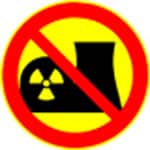Nuclear Power Inherently Risky
Take Action
Join With Us
Resources
Subscribe
A Risk not Worth Taking
Nuclear a Risky Bet
Question the safety or reliability of nuclear power and its proponents are quick to claim that nuclear power plants are the safest and most reliable sources of electricity. That would come as a surprise to residents around the reactors at Three Mile Island, Fukushima and Chernobyl. Germans who live near reactors have seen their children develop higher rates of leukemia, while uranium mines and processing plants have also left a legacy of cancer in their vicinities. Reactor safety is not the only risk. In Texas, frozen equipment shut down a nuclear power plant during a cold snap, when it was most needed. Such events demonstrate that safety and reliability are closely linked.
Operating a nuclear power plant safely requires highly complex systems. When something goes wrong, the plant shuts down. It is not unusual for one or more plants to be shut down for hours, days, weeks, or months to fix one problem or another. For example, in France recently, 28 nuclear plants were shut down because of safety concerns, while others were down for refueling and maintenance, causing electric power shortages. Of course, the power needed to be replaced, resulting in extra costs for utility customers. But it is not just safety issues or refueling and maintenance that can cause a nuclear plant to shut down.
Climate Change Risks
The extreme weather caused by climate change affects the operation of power plants. The Texas incident is but one example. All thermal power plants, including nuclear reactors, need water to make steam and to cool equipment and as a consequence located near bodies of water. With rising water temperatures and drought operations of nuclear plants are at risk. We’ve already seen instances of this occurring here in the US and in Europe. Thermal plants, including nuclear reactors, are located next to the ocean and threatened by rising sea levels. Obviously, climate change is heightening the critical importance of the choices we have to make about using water during droughts, which we are seeing in many regions of the nation. Do we allocate the water to cool nuclear and fossil fuel plants or to grow food, or for drinking water or to preserve fish and wildlife habitat?
Least Risky Path
If we are serious about addressing climate change, we must put our limited dollars into developing energy resources that will make a difference and do so quickly. There are many examples of people investing in proven locally-produced energy that is available now. For instance, in California several communities, businesses and farmers are investing in solar and storage batteries so they will have the power they need when transmission lines go down due to wildfires. Additional benefits are:
• power from these renewable sources is less expensive than from nuclear power;
• power remains available even when transmission lines are affected by wildfire and/or weather; and
• generating power locally makes the electric grid more reliable and reduces the need to build more transmission lines — the electric industry calls this the “non-wires solution.”
Given that climate change effects are increasing, we must ensure that the choices we make today will pay off in the future by adopting the courses of action that involve the lowest risk. Nuclear power does not meet this criterion.
Below in the Resources section you will find papers, articles, videos, etc. documenting nuclear power costs along with solar, wind, and energy efficiency.
• Working with other organization in the West to make sure consumers have safe, affordable, and reliable power.
• Reaching out to the Northwest residents make them aware that nuclear energy is not a viable climate action.
• Supporting the deployment of local energy sources that will keep electric rate affordable for all such as energy efficiency and solar.
Utilities in the Pacific Northwest are in the process of planning for reducing their carbon footprint and while some are looking at energy efficiency and conservation along with renewablea, others are unfortunately looking to nuclear power. It's important we encourage those utilities seeking nuclear free options to continue down that path. At the same time, we need to let those utilities planning on nuclear power know they need to follow a nuclear free path and focus on local energy projects. Nuclear power costs will only add significant costs to electric bills in addition to the increased costs for fixing the electric grid for reliability.
Action Needed Now!
Tell Your Electric Utility
Now is not the time to solve one problem with another, one that will increase electric rates and impact future generations with radioactive waste. Let your utility know you want your ratepayer dollars to be used for energy efficiency, community renewables, and rooftop solar. Here are the utilities that we know are considering new nuclear reactors:
Clark Public Utility District - Grant County Public Utility District - Pacific Power
Resources
Note: To expand the table go the bottom of the table and on the righthand corner click on "View larger version." For more help view the Document Library Guide.
